Nation Sites
The Nation Network
FlamesNation has no direct affiliation to the Calgary Flames, Calgary Sports and Entertainment, NHL, or NHLPA
The Flames are different, but are they better than last season’s team?

Photo credit: Kim Klement-USA TODAY Sports
The last time the Calgary Flames played a game was May 19, when they beat the Vancouver Canucks by a 6-2 score. Since that date, the Flames have made a ton of changes to their reserve list (and more specifically several to their NHL roster).
They’re a bit different than they were when we last saw them: but are they a better hockey club?
To explore if the Flames are actually better, we’ve dug into the numbers for the 22 players that we expect to be on the club’s opening night roster.
Forwards
For the forwards, we’ve looked at Goals Above Replacement (GAR), as calculated by the fine folks at Evolving-Hockey. We’ve looked at each player’s GAR from 2020-21, their average GAR over their past three seasons, and a weighted average calculation giving triple weight to 2020-21, double to 2019-20, and single weight to 2018-19, to emphasize the impact of their more recent hockey played.
A 0.0 GAR indicates a player is replacement level. A positive value means they’re better than replacement, a negative means they’re below replacement.
Last Season | Last Three | Last Three, Weighted | |
Johnny Gaudreau | 11.3 | 10.5 | 9.5 |
Elias Lindholm | 9.9 | 8.7 | 8.5 |
Matthew Tkachuk | 8.8 | 9.5 | 9.7 |
Andrew Mangiapane | 6.9 | 8.3 | 8.4 |
Sean Monahan | 0.0 | 4.4 | 2.4 |
Blake Coleman | 5.5 | 7.2 | 7.3 |
Dillon Dube | 2.9 | 2.3 | 2.8 |
Mikael Backlund | 6.4 | 5.9 | 6.2 |
Tyler Pitlick | -1.3 | 2.0 | 1.8 |
Milan Lucic | 5.4 | 4.3 | 5.2 |
Brad Richardson | -0.5 | 0.7 | -0.3 |
Trevor Lewis | 0.1 | 1.4 | 1.5 |
Brett Ritchie | -3.9 | -4.9 | -4.0 |
Departing the Flames were Derek Ryan (7.1 GAR in 2020-21), Joakim Nordstrom (2.9 GAR), Josh Leivo (0.5) and Dominik Simon (-0.2). Sam Bennett (-1.0 GAR with Calgary, 4.5 GAR overall in 2020-21) also departed at the trade deadline.
New to the Flames this off-season were Blake Coleman, Tyler Pitlick, Brad Richardson and Trevor Lewis. Coleman is a very nice add for the team, and he slots into the top six pretty nicely. He’s well above replacement at 5v5 offensive impacts and a little above at 5v5 defense and power play offense. Pitlick, Richardson and Lewis are all above replacement at 5v5 defensive impacts, but otherwise don’t move the needle.
Coleman will play a bigger role than Ryan, so the Flames likely benefit from that swap. Otherwise, they come out about the same by swapping Nordstrom, Leivo and Simon for Pitlick, Richardson and Lewis, though the primary strengths of their new bottom six bodies appear to be defensive.
Defensemen
The off-season defensive swap is where the Flames seem to be lacking.
Last Season | Last Three | Last Three, Weighted | |
Tanev | 11.8 | 6.0 | 7.3 |
Hanifin | -0.2 | 0.0 | 0.0 |
Zadorov | -0.2 | 0.5 | -0.4 |
Andersson | -2.4 | 5.2 | 3.0 |
Valimaki | 2.7 | n/a | n/a |
Gudbranson | -6.1 | -3.7 | -3.9 |
Stone | 4.0 | -0.8 | 0.2 |
Departing the Flames were Mark Giordano (7.4 GAR in 2020-21) and Nikita Nesterov (-2.3 GAR). They are replaced by Nikita Zadorov and Erik Gudbranson, both of which were below replacement last season. Zadorov hovered around replacement the past three seasons, while Gudbranson was below replacement (significantly) over the past three seasons.
Overall, the Flames defensive group really relies on (a) Chris Tanev staying at the same level, (b) Rasmus Andersson bouncing back to his three season average and (c) Noah Hanifin continuing to improve. (His numbers are a bit deceptive, as he was well above replacement with Tanev but had his numbers dragged down during his stint with Andersson.)
If Juuso Valimaki can’t carry the third pairing on his own, the Flames will have some issues.
Goaltenders
Last Season | Last Three | Last Three, Weighted | |
Markstrom | 5.1 | 13.8 | 11.0 |
Vladar | -1.7 | n/a | n/a |
David Rittich (-0.9 GAR in 2020-21) left town at the trade deadline, replaced with Daniel Vladar. Vladar only played five games and so it’s unclear what exactly he is at the NHL level. At this point, Rittich to Vladar may be a bit of a lateral move (and it could be an upgrade if Vladar can be what the Flames goaltending department thinks he has the potential to be).
Long story short…
Are the Flames better? Well, from a pure GAR sense they’re not. Their moves overall were a saw-off for their forward group and their goaltending tandem, but their defensive group is definitively weaker. That said, the team’s overall weaker offensively (aside from adding Coleman) but perhaps a little bit better defensively (at five on five) due to their forward additions and Zadorov.
If you’re thinking along the lines of “sounds like a Darryl Sutter team”, well… yeah. For this group to be successful, based on previous performances, they’ll need to rely on defensive performances, low-event hockey, and some progression and/or bounce-back seasons from their blueline group.
Breaking News
- Flames Prospect Roundup: How the standings shape up entering the holiday break
- NHL Notebook: Sidney Crosby takes sole possession of most points in Penguins’ franchise history
- FlamesNation Mailbag: Waiting for Santa with reader questions
- Flames injury news: positive signs for Martin Pospisil
- Recap: Martin Frk leads Wranglers to memorable Winter Wranglerfest win in more ways than one
